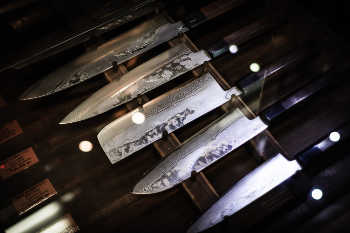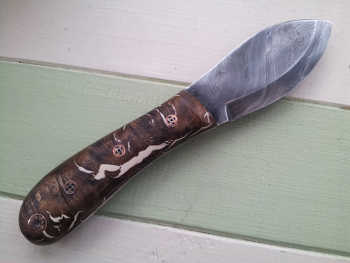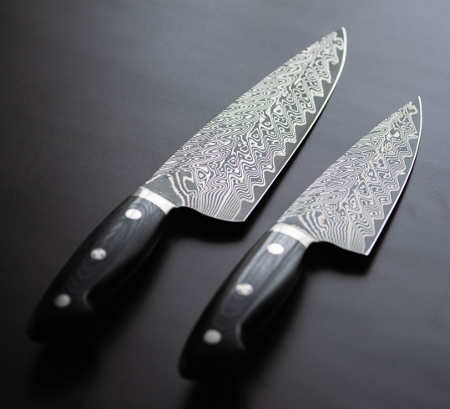In my opinion, Damascus steel is one of the prettiest metals out there. It’s most commonly used for steel knives. But while it looks beautiful, is it just for aesthetics, or does it actually make an excellent all-around knife?
Damascus steel is a layered type of metal that has a distinctive wave pattern that runs throughout the metal. It’s commonly used to create knives, and a wide range of decorative objects.
Other types of steelwork have a long history, but perhaps none have quite the mystique associated with Damascus steel.
In this article, I’ll explain what makes Damascus steel unique, whether it’s as strong as regular steel, how to care for it, and more.
What’s So Special About Damascus Steel?
The first thing you’ll notice about a piece of Damascus is its signature pattern. The metal appears watery or wavy, with different shades of light and dark grey metal running through it.
It isn’t just for looks though. A quality Damascus blade also keeps a good edge, and is both hard yet flexible. More on that a bit later.
When you’re talking about Damascus steel, it’s important to note that there are two types. Pattern-welded and cast Damascus. I’ll explain both in more depth later on as well.
Is Damascus Steel Stronger Than Regular Steel?
These days, Damascus steel is getting more and more popular for all kinds of metal pieces. But you probably want to know: Is it strong, or more just for showpieces?
Damascus isn’t necessarily the strongest steel on the market today. Since the 19th century, we’ve had high-carbon steels that are better. But for its time, Damascus was a magnificent invention, and definitely a huge step up from the iron tools that came before it.
Even if it’s not the strongest metal out there, it’s still plenty strong enough for most applications like kitchen knives, golf club heads, and more.

Just like most other kinds of steel you can buy, Damascus steel can greatly vary in quality. Since Damascus is made of multiple different metals welded together, there’s room for better or worse techniques.
What’s the difference between blacksmithing and welding? Find out in my other article — What’s The Difference Between Blacksmithing And Welding?
High-quality Damascus is forged with extreme care to avoid cracks and voids. If you have a high-quality piece of Damascus, you don’t really need to worry about delamination, or the different layers coming apart. But in particularly cheap pieces of Damascus, weak points may form along where the metal has been fused together if not done well.
Watch out for cheap Damascus out there, especially if you’re a blacksmith buying pre-made Damascus steel billets for your own projects. Remember that you get what you pay for.
Cheaper Damascus knives might be available in the range of $50 to $100. But you really aren’t likely to get a high-quality Damascus knife for less than $200.
Why Is It Called Damascus?
Like a lot of things that have been around for hundreds of years, nobody can say for sure exactly where Damascus steel got its name.
Here are a few of the main theories, although there is some controversy about which is correct.
Perhaps the most logical theory is that Damascus refers to swords that were initially forged in Damascus, a city located in modern-day Syria.
The name could also come from the word damas, which is an Arabic word meaning “water.” This could refer to the watery ripple effect on Damascus blades. It also has similarity in appearance to a type of cloth called damask fabric.
One final theory is that Damascus swords were originally made by a swordsmith named Damasqui.
Regardless of the exact origin of the name, it’s pretty clear that Damascus metal is originally Arabic in origin.
Ever wonder where blacksmithing got its name? Check out my other article — Why Is It Called A Blacksmith? Where Blacksmithing Got Its Name — to find out.
What Kind of Steel Is Used For Damascus?
Modern Damascus steel is made from a variety of different kinds of steel and strips of iron that are welded together to create billets. Each blade maker can use different kinds of metals in their steel, depending on the needs of the particular piece.
The steel is folded or sandwiched with other metals to create hundreds of layers of different thicknesses and patterns.
Every piece of Damascus is unique, and it’s rare to see Damascus steel produced in an assembly line. It’s usually individually customized and made by hand.
Can Damascus Steel Rust or Tarnish?
Since modern Damascus steel is made from all different kinds of metals, it really depends what is put into them. The kind of steel and other metals used will determine if it’s going to rust or tarnish.
But the majority of Damascus metal used in kitchen knives and home applications won’t rust. Stainless Damascus steel has been heat treated.
Carbon Damascus is softer for blacksmiths to work with, but hardens even harder than stainless. However, high-carbon Damascus knives need to be kept clean and tried immediately after being used. Carbon Damascus should also be regularly oiled to prevent it from rusting.
So if you want to cut down on maintenance, I’d recommend going with stainless Damascus.
Are There Different Types of Damascus Steel?
One of the most fascinating things about Damascus metal is that nobody has been able to replicate how it was originally made in ancient times.
Original Damascus steel used wootz, which was a type of steel made in India that’s no longer available. It was first produced over two thousand years ago, but stopped being made in the 1700s and no one has the original techniques to make it any more. Many scientists have tried to reverse engineer existing Damascus steel pieces to figure it out, but so far nobody has managed to cast a similar metal.
It’s believe that wootz steel was made by melting steel and iron with charcoal in an atmosphere with almost no oxygen. This made the metal absorb carbon from the charcoal. The alloy was then slowly cooled which created carbide.
So any “real” Damascus steel pieces in existence today are hundreds of years old.

However, we do have modern pattern-welded Damascus steel. This isn’t real Damascus, and mostly just gives a similar appearance.
Some cheaper products marketed as Damascus are simply etched, or surface treated, to create the typical Damascus pattern. It’s not real Damascus steel with layers going all the way through, and the pattern can actually be worn off the surface of the steel over time.
Pattern-welded Damascus has the folded metal which creates patterns all the way through the metal. It’s about as close as we can get to the original thing. Steel and iron are layered and hammered at very high temperatures to weld them together. Flux is used to seal any small joints and keep oxygen out.
Some products marketed as Damascus may actually be created using an entirely different technique called san-mai. This is a Japanese steel commonly made by sandwiching three sheets of steel together. Usually a hard carbon steel core and two outer pieces of stainless steel. No folding of the metal is done with san-mai blades.
Wondering what the difference between iron and steel is? Find out in my other article here — What Is The Difference Between Iron And Steel?
Is Damascus Steel Good For Kitchen Knives?
A modern high-quality Damascus kitchen knife will hold its edge well. They’re usually made with a harder high-carbon inner core surrounded by softer stainless steel. This hard inner core can keep the blade’s edge sharper than a purely stainless steel knife. While having the exterior made of stainless helps keep the harder steel from being chipped away.
Like all metals really, you get what you pay for. High-end Damascus steel knives are famous for keeping a good edge and being very sharp. However, cheaper Damascus kitchen knives might just be made for the sake of the pattern, without concern for how the blade will actually function.
How To Care For Your Damascus Steel Knife
Like I mentioned earlier, stainless steel Damascus steel knives don’t require much in the way of maintenance. If it has a chromium content of more than 11%, you don’t really need to worry much about rust.
But for carbon steel Damascus blades, you’ll want to lubricate the blade. These types of Damascus don’t have much chromium in the blade, so it’s more prone to rust. So keep these kinds of blades clean, and dry to prevent them from becoming discolored or rusty.
Once your Damascus steel knife is clean and dry, you can help keep it rust-free by either oiling it or lubricating it with wax.
For all Damascus steel, you’ll want to avoid using rough cloths, steel wool, or anything else abrasive. These could damage the look of your blade and might actually remove the etched surface of the metal. You might also want to avoid particularly acidic foods, like lemons.
How Do You Sharpen A Damascus Knife?
Damascus kitchen knives have an added advantage that the layered steel adds micro-serrations along the edge of the blade to keep it extra sharp. But despite this, Damascus steel knives don’t require any special techniques when it comes to sharpening.
You can use a regular knife sharpener. But for high-quality Damascus blades, it’s recommended to sharpen using a whetstone instead.
Damascus knives will tend to stay sharper for longer than regular stainless steel. So you should get more use out of it between sharpenings.
Conclusion
Damascus steel isn’t just nice to look at, but it’s practical and can even be better than stainless steel for some applications as well.
Modern Damascus isn’t exactly what we would historically call Damascus steel. If we’re being honest, it’s technically a pattern-welded steel. But since it appears that the true techniques needed to make the original Damascus were lost forever, it’s probably as close as we will ever get.
If you’re looking to buy some Damascus steel kitchen knives online, I’d start by looking at these ones. (Amazon link) You can either pick up a 5-piece set or buy them individually.

